Cat Safe Plants: 12 Gorgeous Picks That Thrive Indoors
Cat safe plants are essential for pet owners who want to bring greenery indoors without compromising their feline friends’ health. As a pet owner, you want your home to be warm and welcoming for everyone, including your furry companions. Adding some greenery indoors is a smart move – it purifies the air and lifts your mood.
However, if your cat loves to chew on leaves, you need to select indoor plants with pets in mind carefully. This ensures your home remains a haven for them.
Choosing pet-friendly plants is a great way to enjoy indoor gardening while keeping your pets happy and healthy. In this article, we’ll show you 12 beautiful “cat safe plants” that will transform your space without putting your feline friends at risk.
Table of Contents
The Importance of Pet-Friendly Greenery in Your Home
Creating a pet-friendly home is key for cat owners. It ensures their pets live happily and healthily with indoor plants. When decorating with plants, it’s vital to think about your cat’s safety.
The Dangers of Toxic Plants for Cats
Numerous indoor plants pose health risks to cats, ranging from minor discomfort to serious medical conditions. Plants like lilies, sago palms, and tulips are very dangerous. If your cat eats any part of these plants, it could be very bad for their health.
To keep your cat safe, you must avoid toxic houseplants for cats. Knowing which plants are toxic before bringing them home can prevent poisoning.
Benefits of Indoor Plants for Both You and Your Cat
Indoor plants make your home look better and offer many benefits. They clean the air, reduce stress, and create a calm space. Choosing cat-safe plants like spider plants or catnip can make your cat’s life better, giving them something fun to do.
By picking the right plants, you can make a healthy and happy indoor space for everyone. Whether you want to improve air quality or just add some green, there are many cat-friendly plants to pick from.
Understanding Cat Safe Plants and Their Benefits
Cat-safe plants are more than just decorations. They help keep your home healthy and safe for your cat. By picking the right plants, you can make your home look better and keep your cat safe.
When picking plants, think about how they’ll look in your home and how they’ll affect your cat’s health. Cat safe plants make your home look good and improve the air quality.
Health Benefits for Your Home Environment
Indoor plants, especially cat safe plants, are good for your health. They clean the air by removing bad stuff, making your home healthier for you and your pet. Some safe flowers for cats, like Spider Plants, are great at cleaning the air.
Also, plants can make you feel better and less stressed. Being around plants can improve your mood and mental health. Adding cat safe plants to your home can make it a calm and peaceful place.
Creating a Safe and Enriching Space for Your Feline
For cat owners, it’s about more than just plants. It’s about making a safe space for your cat. Cats like to explore and smell plants. By choosing cat safe plants, you can keep your cat safe from harm.
Some plants can even make your cat’s life better. For example, Catnip or Wheat Grass can excite your cat’s senses and encourage natural behaviors. Adding these plants to your home can make it a better place for your cat.
12 Stunning Cat Safe Plants Perfect for Indoor Environments
You don’t have to choose between having cats and plants in your home. Many cat-safe plants can make your indoor space beautiful and fresh. Here are the first six plants from our list of 12 gorgeous cat-safe plants that thrive indoors.
1. Spider Plant (Chlorophytum comosum)
The Spider Plant is a popular choice for indoor gardens. It’s easy to care for and looks great. It’s perfect for both beginners and experienced plant owners.
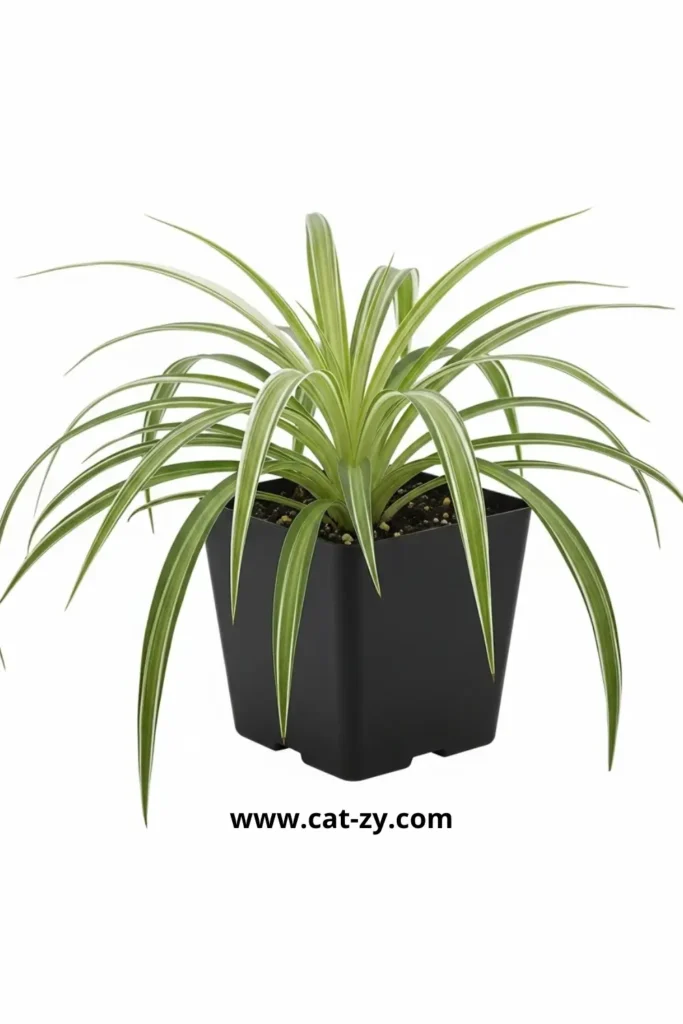
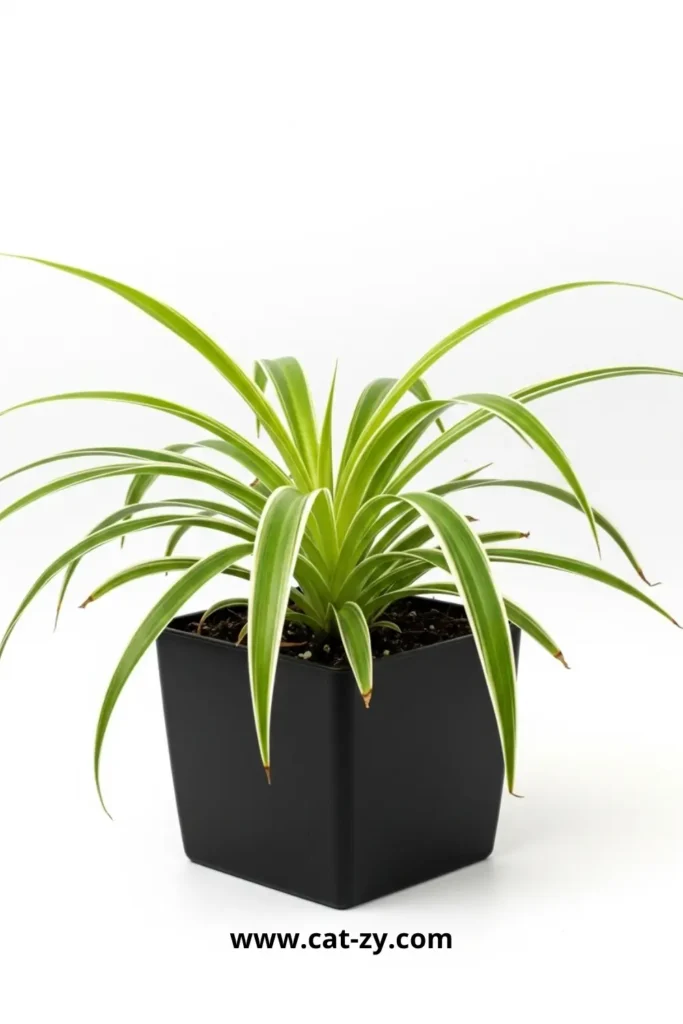
Care Requirements
Spider Plants like bright, indirect light but can handle different lighting. They need to be watered well, letting the soil dry a bit between waterings. Regular pruning keeps them looking good and growing well.
Benefits for Your Home
Spider Plants offer feline safety while naturally cleaning your indoor air. They remove toxins like formaldehyde and xylene. They’re a wonderful addition to any room, bringing greenery and freshness.
2. Boston Fern (Nephrolepis exaltata)
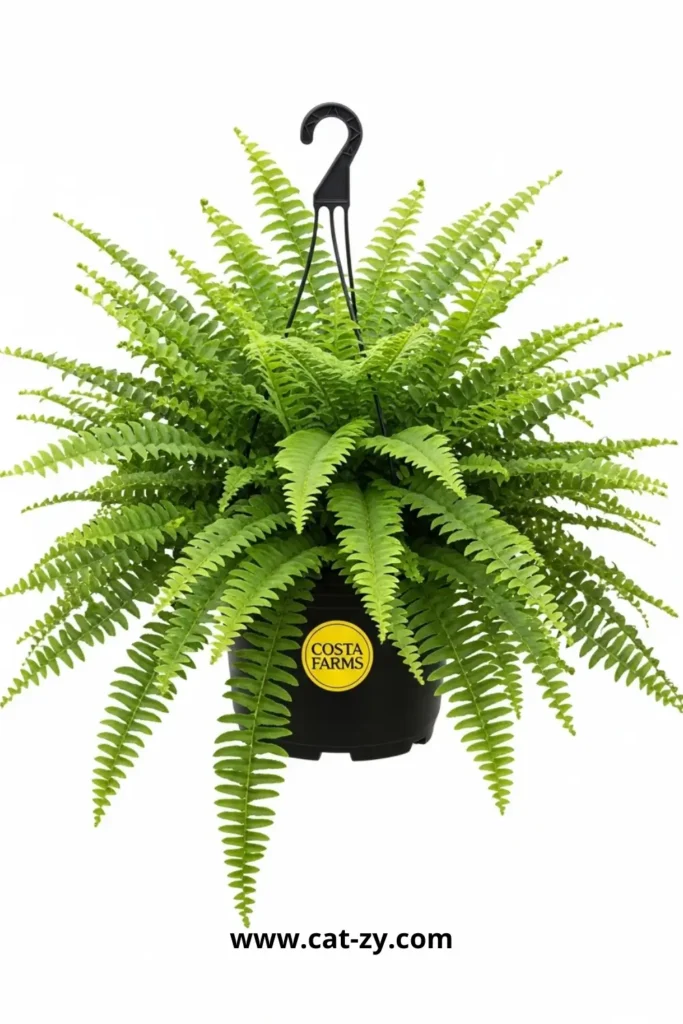
Boston Ferns have lush, green foliage and can make your home feel tropical. They need a bit more care, but are worth it.
Care Requirements
These ferns love humid environments and bright, indirect light. They need regular watering to keep the soil moist.
Benefits for Your Home
Boston Ferns are not toxic to cats and improve air quality. They add a lush texture to your indoor spaces, making them great for decorating.
3. Areca Palm (Dypsis lutescens)
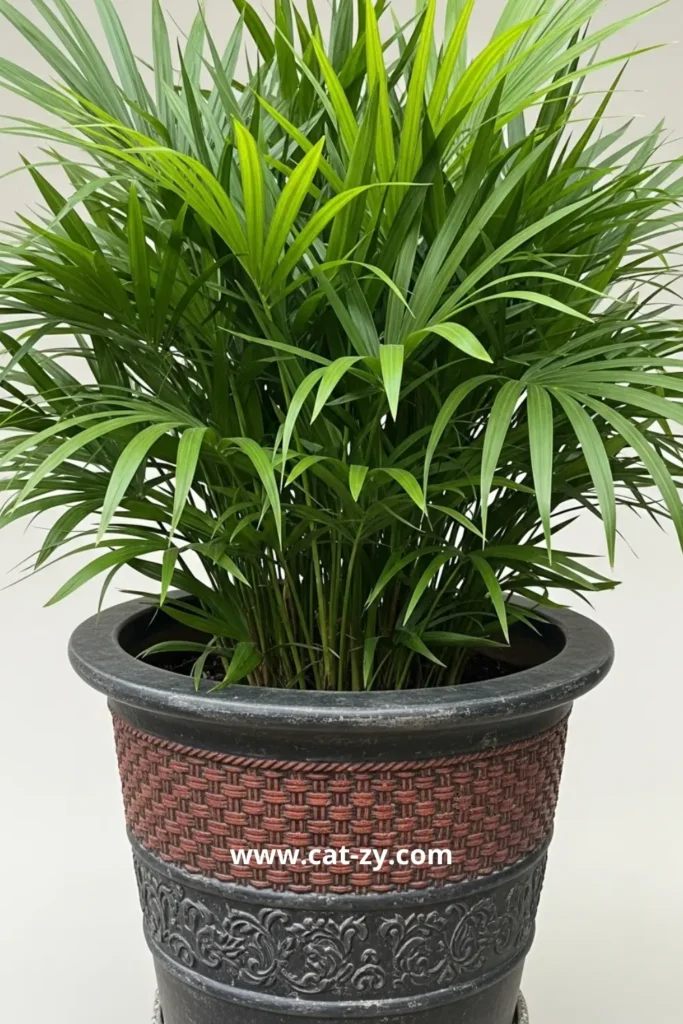
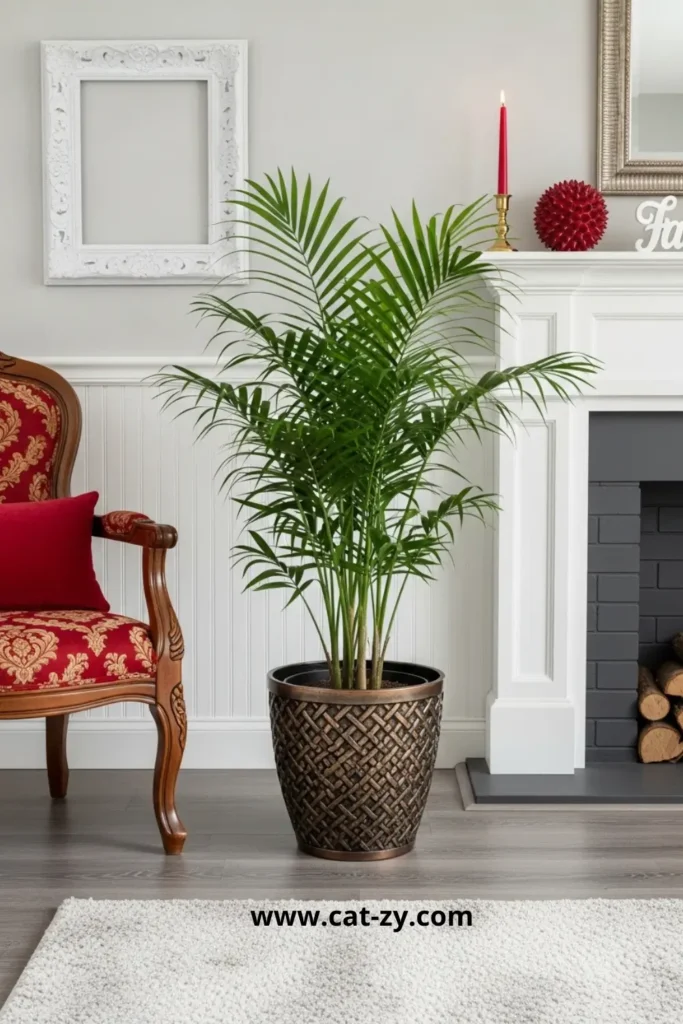
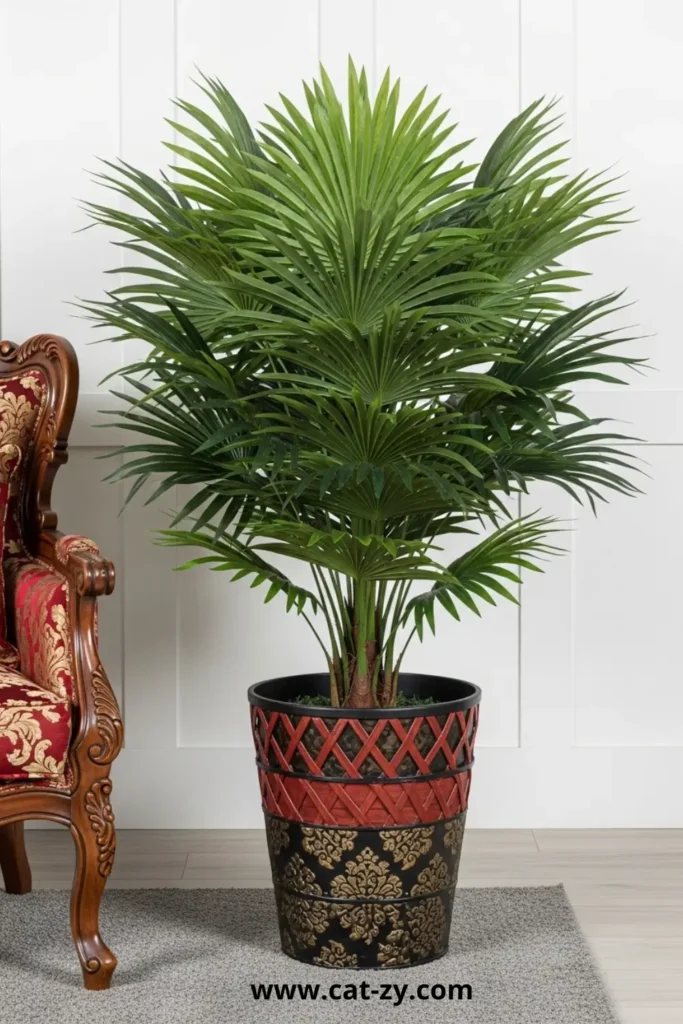
The Areca Palm is stylish and safe for cats. It has feathery leaves and can grow tall, making it a statement piece.
Care Requirements
Areca Palms prefer bright, indirect light and consistent watering. They do well with regular fertilization during the growing season.
Benefits for Your Home
Areca Palms provide cat safety while naturally moisturizing your home’s atmosphere. They add elegance to any room.
4. Calathea (Prayer Plant)
Calathea, or Prayer Plant, is known for its vibrant foliage and unique patterns. This plant serves as an excellent option for enhancing indoor visual appeal.
Care Requirements
Calathea prefers well-draining soil and high humidity. It does well in bright, indirect light but can’t handle direct sunlight.
Benefits for Your Home
Being non-toxic to cats, Calathea is a safe choice. It adds color and visual interest to your home, making it a great decorative piece.
5. Parlor Palm (Chamaedorea elegans)
The Parlor Palm is slender and elegant, perfect for indoor spaces. It’s low-maintenance and can thrive in various conditions.
Care Requirements
Parlor Palms thrive in bright, filtered light and require thoughtful watering practices. Regular misting helps keep the humidity they prefer.
Benefits for Your Home
Parlor Palms are cat-safe and purify the air. They add sophistication to any room with their elegant leaves.
6. African Violet (Saintpaulia)
African Violets are charming plants with delicate, colorful flowers. These plants excel in indoor environments, particularly in compact areas.
Care Requirements
African Violets flourish with bright, filtered lighting and steady hydration levels. They thrive in humid environments and need regular fertilization to bloom.
Benefits for Your Home
These plants are safe for your cats and add color with their beautiful flowers. They bring warmth and coziness to your indoor spaces.
More Gorgeous Cat Safe Plants That Flourish Indoors
Many more cat-safe plants can brighten up your home. These plants are not only beautiful but also keep your cats safe and happy.
7. Peperomia
Peperomia is a lovely, easy-to-care-for plant. It comes in many patterns and colors, making it perfect for your cat-friendly garden.
Care Requirements
Peperomia loves high humidity and indirect light. Maintain damp soil conditions while preventing oversaturation to protect against root decay.
Benefits for Your Home
This plant is safe for cats and also cleans the air. Its small size is great for small spaces.
8. Christmas Cactus (Schlumbergera)
Christmas Cactus stands as a feline-friendly blooming plant for your home. This plant produces gorgeous seasonal blooms that bring holiday elegance to your living space.
Care Requirements
Christmas Cactus requires bright, filtered lighting paired with balanced hydration. It blooms best in cooler temperatures.
Benefits for Your Home
This plant is non-toxic to cats and blooms for months. Its low-maintenance nature makes it ideal for pet owners with demanding schedules.
9. Haworthia
Haworthia is a small, safe succulent for your cats. It comes in various shapes and sizes, adding uniqueness to your garden.
Care Requirements
Haworthia prefers well-draining soil and indirect sunlight. It’s okay if you forget to water it sometimes.
Benefits for Your Home
Haworthia is not only cat-safe but also purifies the air. The compact dimensions and minimal care requirements suit indoor environments perfectly.
10. Money Tree (Pachira aquatica)
Money Trees represent a well-loved cat safe plant traditionally associated with prosperity. It can grow tall, making it a standout in any room.
Care Requirements
Money Trees prefer bright, indirect light and moderate watering. They adapt well to different environments, fitting various homes.
Benefits for Your Home
This plant is known for its air-purifying abilities and is considered lucky. It’s also easy to care for, great for pet owners.
11. Staghorn Fern (Platycerium)
The Staghorn Fern is a unique, cat-safe plant that adds an exotic touch to your garden. It grows without soil.
Care Requirements
Staghorn Ferns require bright, filtered lighting combined with elevated moisture levels. These plants benefit from consistent hydration without excessive moisture.
Benefits for Your Home
This fern offers feline safety while introducing exotic elegance to your interior. It’s a great air purifier and can be mounted or placed in a basket.
12. Bamboo Palm (Chamaedorea seifrizii)
The Bamboo Palm is a cat-safe, elegant plant that can grow tall. It has feathery leaves and purifies the air.
Care Requirements
Bamboo Palms thrive with bright, filtered light and balanced moisture levels. They are easy to care for and thrive in different conditions.
Benefits for Your Home
This palm ensures feline safety while naturally filtering your indoor atmosphere. It adds tropical elegance to any room.
Toxic Houseplants to Keep Away from Your Feline Friends
Choosing the right plants is key when you have a cat. While numerous plants pose no risk, certain varieties can endanger your feline companion. Knowing which toxic houseplants for cats to avoid is important.
Common Dangerous Plants for Cats
Some houseplants are bad for cats. For example, Lilium (Lily) and Dieffenbachia (Dumb Cane) can be very harmful. Even a little bit can cause big problems, so keep these plants away.
Other plants like Sago Palm and Oleander are also dangerous. Knowing what plants are toxic to cats helps you pick safer options for your home.
Recognizing Symptoms of Plant Poisoning
If your cat eats a toxic plant, spotting the signs early is key. Look for vomiting, tiredness, and not wanting to eat. In worse cases, they might have trouble breathing, shake, or even have seizures.
Should you suspect your cat consumed a harmful plant, seek immediate professional assistance. Quick action can help your cat get better.
Practical Tips for Growing Cat Safe Plants Successfully
With the right strategies, you can grow cat safe plants that thrive. These plants will keep your cats happy and healthy. Developing an attractive indoor garden that accommodates your cat’s demands requires thoughtful preparation and attention.
Strategic Placement and Protection Methods
One key factor is placing indoor plants with pets where cats can’t reach them. Employ elevated surfaces or suspended containers to protect your plants. Plant covers or barriers can also stop cats from nibbling on leaves or digging in the soil.
Preventing Soil Digging and Plant Damage
Cats often can’t resist digging in indoor plant soil. To stop this, place decorative rocks or shells on top of the soil. This not only stops digging but also adds beauty to your plants. Also, use pots with stable bases and secure them to prevent accidental knockovers.
By using these strategies, you can enjoy cat safe plants while keeping your pets safe and happy.
Creating a Harmonious Indoor Garden for You and Your Cat
To enjoy indoor plants safely with your cat, design a harmonious garden. Choose the right plants and place them wisely. Make sure your cat’s curiosity doesn’t harm them.
Balancing Plant Health with Cat Safety
Creating a cat-friendly garden is a challenge. Choose plants that are non-toxic to cats. Check your plants for stress or disease signs and act fast.
Keep your plants clean and avoid harmful chemicals. This way, you’ll have a healthy space for both plants and pets.
Designing Cat-Friendly Plant Spaces
Think about your garden’s layout and its impact on your cat. Position plants beyond your cat’s access, such as on elevated surfaces or in suspended planters. Create a safe zone with cat grass or catnip for your cat to enjoy.
With careful planning, you can have a beautiful garden and a happy cat. This balance makes your home a peaceful place for both you and your pet.
Crisis Management: Steps When Your Cat Consumes Plant Material
If your cat eats a plant, staying calm is key. Many cat owners don’t know the dangers in their homes until it’s too late. Knowing how to act can prevent a minor issue from becoming serious.
Immediate Action Steps
If you see your cat eating a plant, stay calm and act fast. First, identify the plant to check if it’s toxic. If it is, or if you’re not sure, don’t wait for symptoms. Contact your veterinarian or animal poison control service immediately.
Prepare the plant’s identification tag or specimen for your veterinary professional.
When to Seek Veterinary Care
Even if you’re not sure about the plant’s safety, it’s safer to be cautious. If your cat seems sick, like vomiting or acting tired, get vet help right away. Your vet might need to make your cat vomit or give special treatments.
Quick action can help your cat get better.
Conclusion
Selecting cat safe plants enables you to maintain an attractive yet secure indoor garden. It’s good for you and your cat. Adding indoor plants to your home makes it look better and healthier.
To keep things safe, use the tips from earlier. This includes placing plants carefully and using protection. This way, you and your cat can enjoy the plants without worry.
With the right cat safe plants, your home can become a peaceful and lively space. This approach ensures satisfaction for both you and your feline companion. Remember to pick plants that are safe for your pets to ensure a happy home.
FAQ
What are some cat-safe plants that I can have in my home?
You can have many cat safe plants like Spider Plant, Boston Fern, and Areca Palm. Calathea, Parlor Palm, and African Violet are also safe. Peperomia, Christmas Cactus, Haworthia, Money Tree, Staghorn Fern, and Bamboo Palm are good choices too.
What methods prevent my cat from consuming my indoor plants?
Place plants out of your cat’s reach. Use covers or deterrents. Provide your feline with cat grass or alternative edible plant options.
What are the symptoms of plant poisoning in cats?
Watch for symptoms including nausea, digestive upset, fatigue, and reduced eating. Should you suspect your cat ingested a poisonous plant, obtain veterinary assistance immediately.
Are there any benefits to having indoor plants with pets?
Yes, cat safe plants can clean the air and reduce stress. These create a peaceful environment for both you and your feline friend.
How can I create a cat-friendly indoor garden?
Choose cat safe plants and position them strategically. Use planters that won’t tip over. Create a cat agility area or add cat towers near plants.
What should I do if my cat eats a plant that is toxic?
Stay calm and call your vet or a pet poison hotline. They’ll tell you what to do next.
Is it possible to maintain an attractive indoor garden while owning cats?
Yes, you can have a beautiful garden that’s safe for your cats. Choose safe plants, use creative planters, and design a space that looks good and works well.
Is Lavender Plant Safe for Cats?
No, lavender is toxic to cats. It contains compounds that can cause stomach upset, especially in oil form. Consider safe alternatives like Catmint or Russian Sage.
What Plants Are Safe for Cats?
Safe options include basil, dill, zinnias, marigolds, sunflowers, cat grass, and air plants. Always check plant safety through trusted sources like the ASPCA database.
Are Spider Plants Safe for Cats?
Yes, Spider Plants are non-toxic to cats. They’re popular in pet-friendly homes and may even attract cats, but eating too much might cause mild stomach upset.

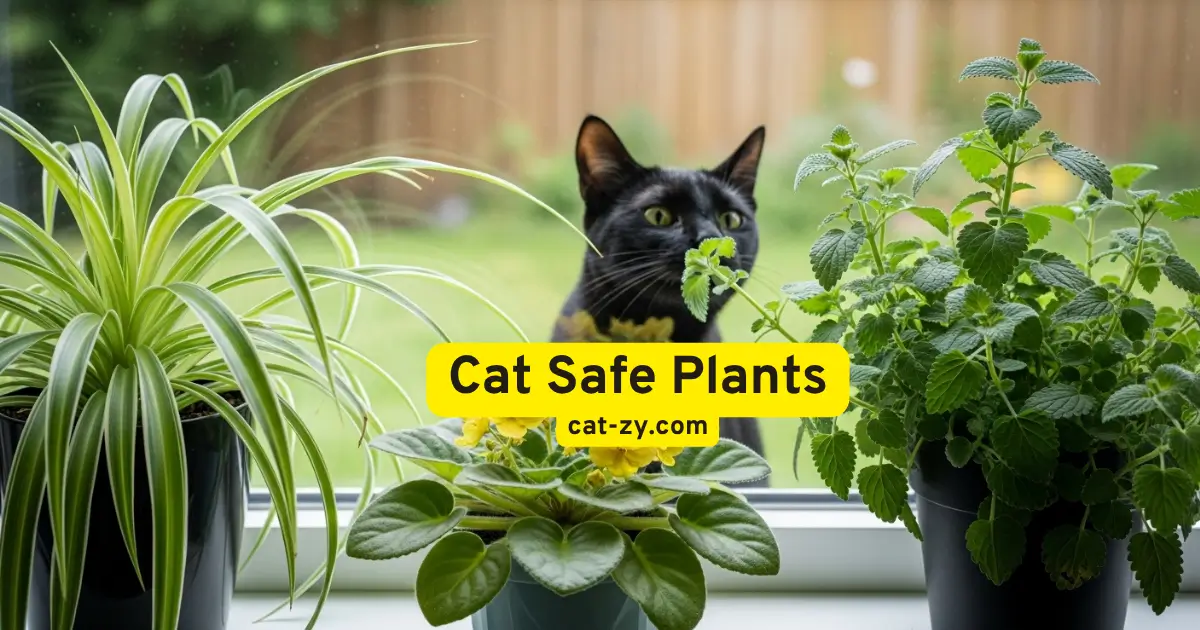

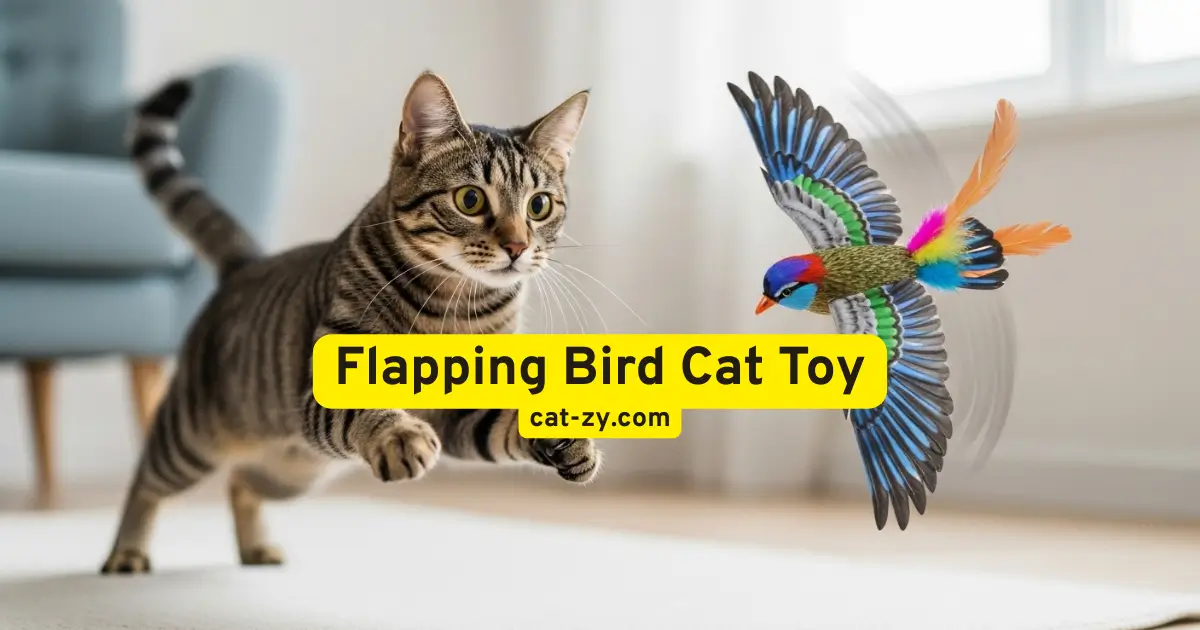
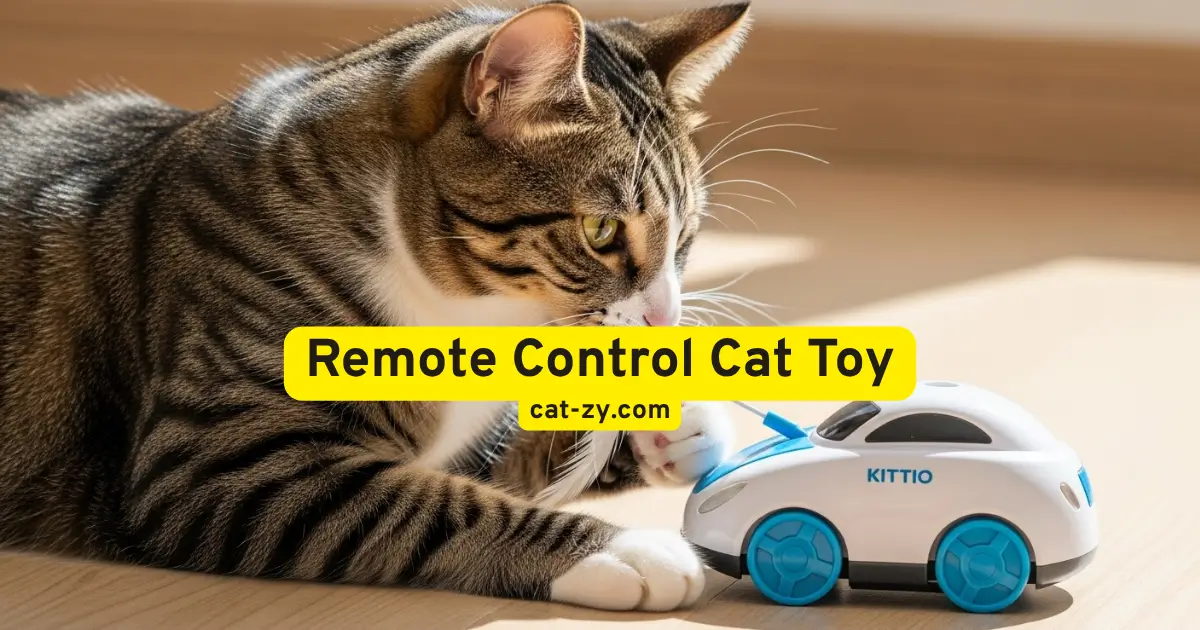
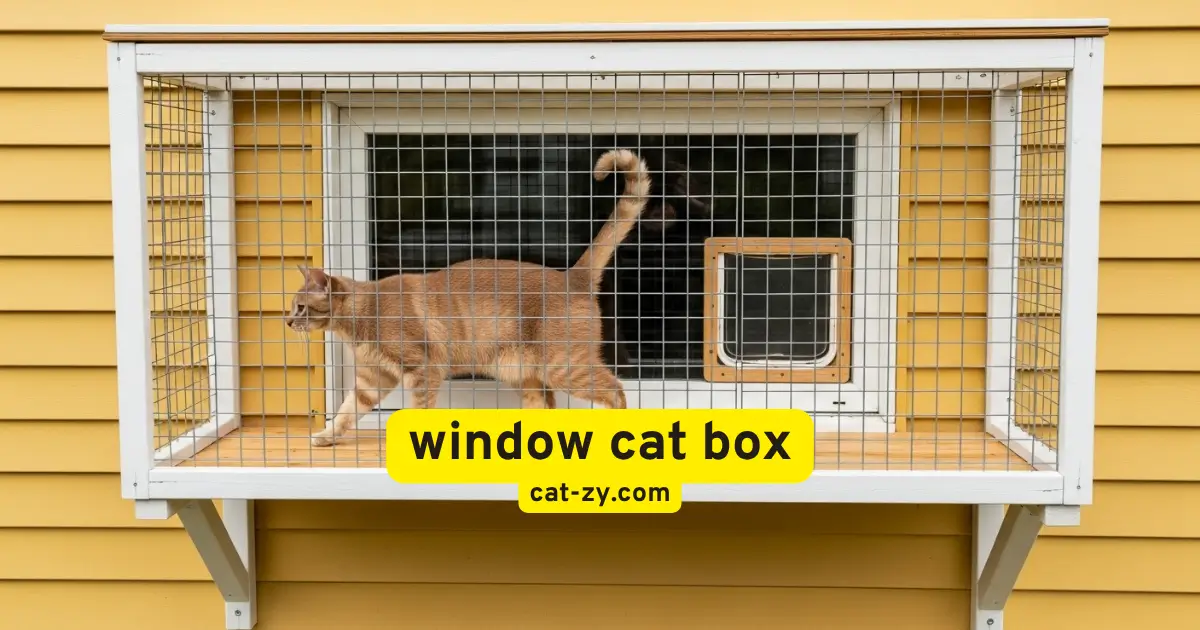
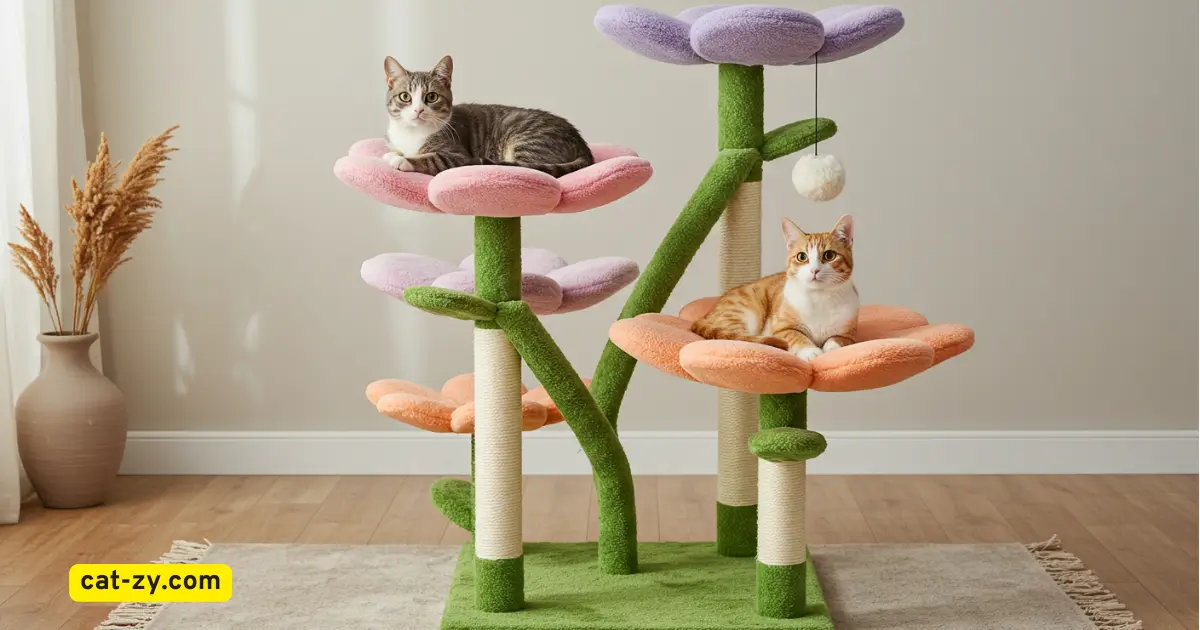
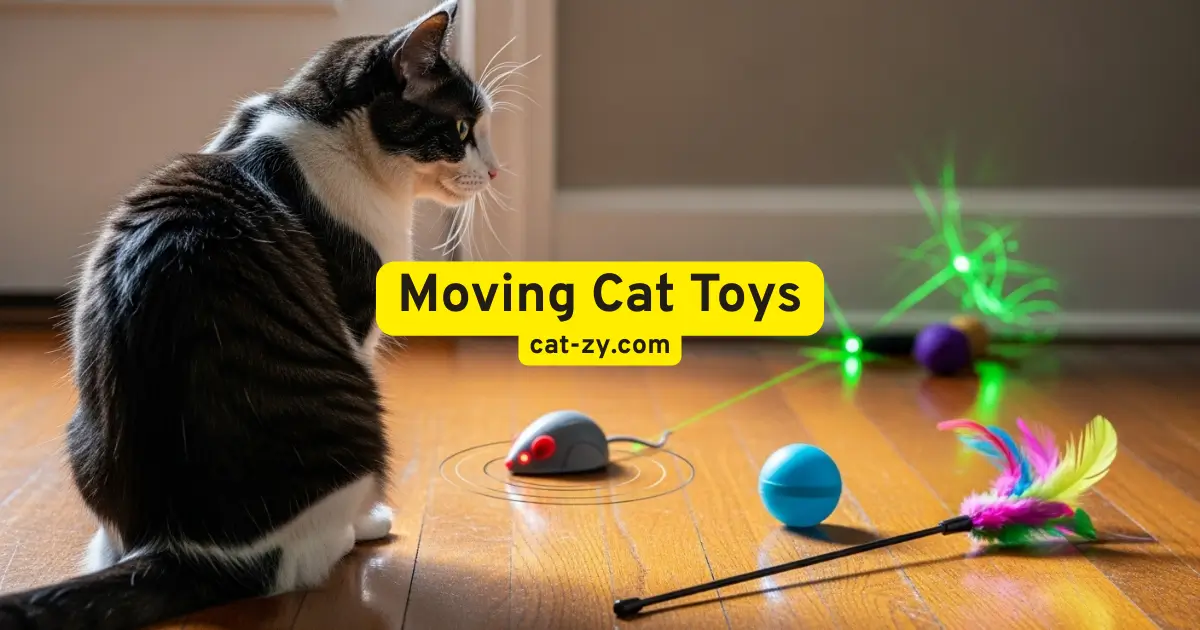
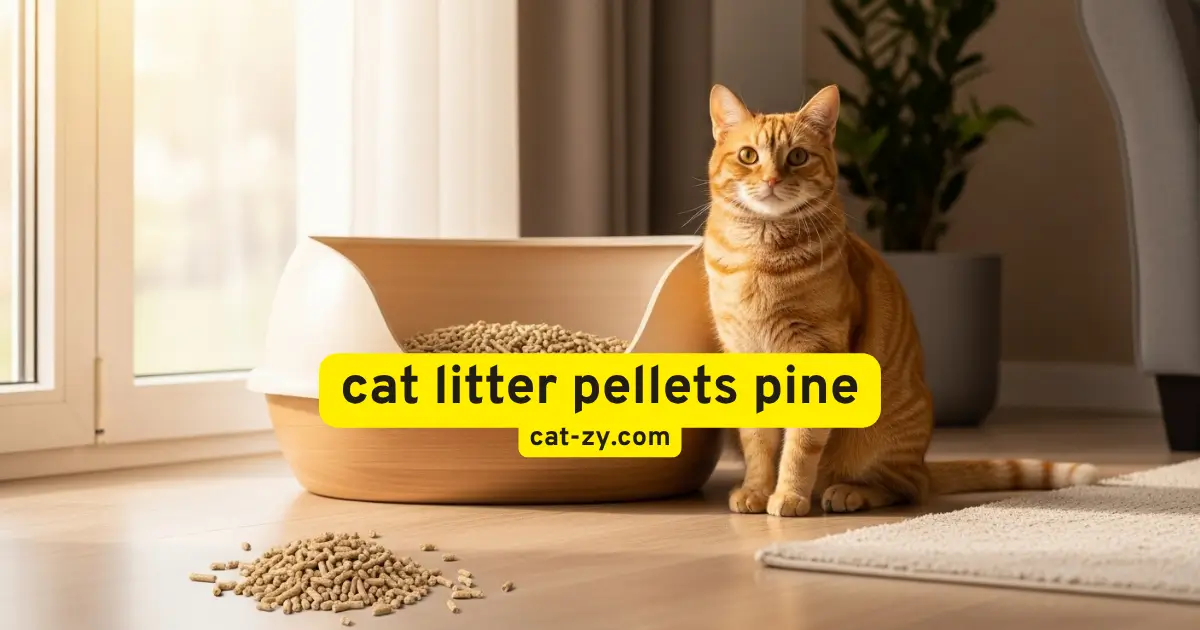
5 Comments
Comments are closed.